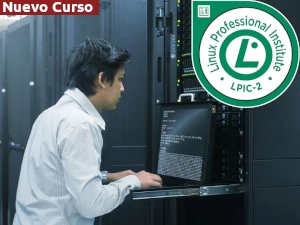El curso certificación en Linux LPI Nive2 en videoconferencia; está dirigido a estudiantes y profesionales que deseen dar los exámenes de certificación Linux Professional Institute Nivel 2 – Linux Engineer (exámenes 201 y 202) en el menor tiempo posible.
El curso le permitirá conocer el despliegue de servidores Linux con las distribuciones Rocky Linux 10 (Clon de RHEL 10), Debian 13, Ubuntu Server 24.04 y CentOS 6 (Sistema Legado)
Conocerá detalles de la administración avanzada de Linux, incluyendo la compilación del kernel Linux y sus módulos; podrá administrar de manera avanzada la gestión de discos, raid software y LVM, conocerá de manera detallada el despliegue de redes Linux, podrá configurar servidores Linux y desplegar servicios de DNS, DHCP, SSH, Servidores Web Apache y Ngnix, Samba, FTP y de Correo Electrónico. También conocerá el despliegue de un Firewall Perimetral con Iptables, VPN y Proxy Web.
Al final del curso estará capacitado para poder brindar los exámenes de certificación LPI 201y LPI 202 versión.
Calendario y Costo:
Duración: 44 horas, 5 semanas
Horario: Lunes, Miércoles y Jueves de 19:00 hrs a 23:00 hrs (Lima/Bogotá/Quito)
Inicio: lunes, 08 diciembre, 2025
Lugar: Videoconferencia en vivo
Costo del Curso:
$240 USD
Válido solo para personas naturales.
Por empresa contactarse a informes@aulautil.com para solicitar su cotización.
Costo de Exámenes:
Examen 101-500 $ 165 USD
Examen 102-500 $ 165 USD
Nota:
- Examen escrito en español presencial en Lima.
- El costo de examen es solo para los que llevan el curso, si desean dar solo los exámenes, el costo es $200 USD, el exámen es escrito y coordinado con Person Vue para ser tomado en su localidad.
Profesor:
Clever Flores
Master en Linux, y plataformas Open Source.
Certificado en LPI 1, LPI2, LPI 3, RHCSA, RHCE y C)PTE
Requisitos para llevar el curso.
Haber llevado el curso de Linux LPI Nivel 1 si desea obtener la certificación; o como mínimo tener conocimientos básicos de Linux y saber usar el editor vim.
Informes e Inscripciones:
WhatsApp 1: +51 923346146
WhatsApp 2: +51 934946723
Tel: +51 015101819
Medios de Pago:
Fuera de Perú
Vía Paypal por la web o vía transferencia por Western Union/Moneygram
Perú
Puede realizar sus pagos en las cuenta a nombre de Cloud Perú Systems E.I.R.L.
Cuenta Corriente Interbank dólares Cloud Peru
200-3001554252
CCI: 00320000300155425232
Cuenta de detracción Bco. de la Nación: 00057050292
Materiales:
– Talleres Digitales online
– Redes WAN, LAN, DMZ y VPN reales para cada alumno
– Videoconferencia con Jitsi Meet
– Asistencia en tiempo real con AnyDesk
– Asistencia Online (foros) en campus virtual de forma permanente
– Todas las clases se graban y se comparten por YouTube Private
– Incorporación gratis al WhatsApp exclusivo del grupo del curso
– Certificado con valor curricular
– Incluye 4 Servidores VPS y simulacros de exámenes de certificación 201-400 y 202-400; costo por exámen $165 USD
Syllabus del curso de certificación LPIC Nivel 2
Exámen 201
Preparación del Entorno de trabajo de Servidores Linux.
Instalación de Rocky Linux 10, CentOS 6, Ubuntu 24.04 y Debian 13 en servidores VPS.
– Determinación de requerimientos de hardware
– Firmware UEFI y Legacy
– Estructura de Directorios de Linux
– Sistema de Archivos
– Estrategia de particionamiento.
– Instalación completa de Rocky Linux 10, CentOS 6, Ubuntu 24.04 y Debian 13
– Configuración de red
– Instalación física de Linux en Servidores.
Tópico 200: Planificación de Recursos.
200.1 Medir y solucionar problemas del uso de recursos
Descripción: El alumno debe poder medir los recursos de hardware y el ancho de banda de la red, identificar y solucionar problemas de recursos.
Áreas claves de conocimiento:
- Medir el uso de la CPU
- Medir el uso de la memoria
- Medir E/S de disco
- Medir E/S de red
- Medir el rendimiento del firewall y el enrutamiento
- Mapear el uso de ancho de banda del cliente
- Haga coincidir / correlacione los síntomas del sistema con los problemas probables
- Calcule el rendimiento e identifique cuellos de botella en un sistema, incluidas las redes
Lista de utilidades y comandos:
- iostat
- netstat
- w
- top
- sar
- procesos bloqueados en I/O
- bloqueos externos
- vmstat
- pstree, ps
- Isof
- uptime
- swap
- bloqueos internos
200.2 Anticipar las necesidades de recursos futuros.
Descripción: El alumno debe poder monitorear el uso de recursos para predecir futuras necesidades de recursos.
Áreas de conocimiento claves:
- Use herramientas de monitoreo y medición para monitorear el uso de la infraestructura de TI.
- Predecir el punto de interrupción de la capacidad de una configuración
- Observar la tasa de crecimiento del uso de la capacidad
- Grafique la tendencia del uso de la capacidad
- Conocimiento de soluciones de monitoreo como Icinga2, Nagios, collectd, MRTG, Zabbix y Cacti
Tópico 201: El Kernel Linux.
201.1 Componentes del Kernel
Descripción: Los alumnos deben poder utilizar los componentes del kernel que son necesarios para un hardware específico, los controladores de hardware, los recursos del sistema y los requisitos. Este objetivo incluye la implementación de diferentes tipos de imágenes del núcleo, la identificación de parches y núcleos estables y en desarrollo, así como el uso de módulos del kernel.
Áreas claves de conocimiento:
- Versiones del Kernel 2.6.x, 3.x, 4.x y 5.x
Utilidades, directorios y comandos:
- /usr/src/linux/
- /usr/src/linux/Documentation/
- zImage
- bzImage
- xz compression
201.2 Compilando el Kernel Linux
Description: Los alumnos deben poder configurar correctamente un kernel para incluir o deshabilitar características específicas del kernel de Linux según sea necesario. Este objetivo incluye compilar y recompilar el kernel de Linux según sea necesario, actualizar y anotar los cambios en un nuevo kernel, crear una imagen initrd e instalar nuevos kernels.
Áreas claves de conocimiento:
- /usr/src/linux/
- Kernel Makefiles
- Kernel 2.6.x/3.x,4.x,5.x make targets
- Personalizar la configuración actual del kernel.
- Crear un kernel nuevo y desplegar módulos de kernel apropiados.
- Instalar un nuevo núcleo y cualquier módulo.
- Asegúrese de que el administrador de arranque pueda ubicar el nuevo kernel y los archivos asociados.
- Archivos de configuración del módulo
- Utilice DKMS para compilar módulos del kernel.
- Conocimiento de Dracut
Comando y utilidades:
- mkinitrd
- mkinitramfs
- make
- make targets (all, config, xconfig, menuconfig, gconfig, oldconfig, mrproper, zImage, bzImage, modules, modules_install, rpm-pkg, binrpm-pkg, deb-pkg)
- gzip
- bzip2
- module tools
- /usr/src/linux/.config
- /lib/modules/kernel-version/
- depmod
- dkms
201.3 Gestión y solución de problemas del tiempo de ejecución del kernel
Description: Los alumnos deben poder administrar y/o consultar un kernel 2.6.x, 3.x, 4.x o 5.x y sus módulos cargables. Los alumnos deben poder identificar y corregir problemas comunes de arranque y tiempo de ejecución. Los candidatos deben comprender la detección y administración de dispositivos mediante udev. Este objetivo incluye la solución de problemas de las reglas de udev.
Áreas claves de conocimiento:
- Use las utilidades de línea de comandos para obtener información sobre el kernel y los módulos del kernel que se están ejecutando actualmente
- Cargue y descargue manualmente los módulos del kernel
- Determine cuándo se pueden descargar los módulos
- Determinar qué parámetros acepta un módulo
- Configure el sistema para cargar módulos por nombres que no sean su nombre de archivo.
- /proc sistema de archivos
- Contenido de /, /boot/ y /lib/modules/
- Herramientas y utilidades para analizar información sobre el hardware disponible
- reglas de udev
Utlidades, Directorios y Comandos:
- /lib/modules/kernel-version/modules.dep
- Archivos de configuración de módulos en /etc/
- /proc/sys/kernel/
- /sbin/depmod
- /sbin/rmmod
- /sbin/modinfo
- /bin/dmesg
- /sbin/lspci
- /usr/bin/lsdev
- /sbin/lsmod
- /sbin/modprobe
- /sbin/insmod
- /bin/uname
- /usr/bin/lsusb
- /etc/sysctl.conf, /etc/sysctl.d/
- /sbin/sysctl
- udevmonitor
- udevadm monitor
- /etc/udev/
Tópico 202: Arranque del Sistema Operativo.
202.1 Personalización del inicio del sistema SysV-init y SystemD
Description: Los alumnos deben poder consultar y modificar el comportamiento de los servicios del sistema en varios objetivos y niveles de ejecución. Se requiere una comprensión profunda de systemd, SysV Init y el proceso de arranque de Linux. Este objetivo incluye la interacción con los objetivos de systemd y los niveles de ejecución de inicio de SysV.
Áreas claves de conocimiento:
- Systemd
- SysV init
- Linux Standard Base Specification (LSB)
Comandos y Utilidades:
- /usr/lib/systemd/
- /etc/systemd/
- /run/systemd/
- systemctl
- systemd-delta
- /etc/inittab
- /etc/init.d/
- /etc/rc.d/
- chkconfig
- update-rc.d
- init and telinit
202.2 Recuperación del Sistema
Description: Manipular correctamente un sistema Linux durante la secuencia de arranque y en modo recuperación. Usar el comando init y las opciones del núcleo relativas a init. Determinar la causa de los errores en la carga del sistema y con los gestores de arranque. El programa se concentra en los gestores de arranque GRUB 2 y GRUB Legacy, en modo de configuración BIOS y UEFI.
Áreas claves de conocimiento:
-
BIOS y UEFI
-
Arranque NVMe
-
GRUB versión 2 y Legacy
-
Shell grub
-
Arranque del cargador de inicio y activación del núcleo
-
Carga del núcleo
-
Inicialización y configuración del material
-
Inicialización y configuración de los servicios/procesos
-
Ubicaciones de los diferentes gestores de arranque en los discos duros o dispositivos extraíbles
-
Modificación de las opciones estándares de los gestores de arranque y utilización de los shell de los gestores de arranque
-
Uso de los modos systemd rescue y emergency
Comandos y Utilidades:
- mount
- fsck
- inittab, telinit and init with SysV init
- El contenido de /boot/, /boot/grub/ and /boot/efi/
- EFI System Partition (ESP)
- GRUB
- grub-install
- efibootmgr
- UEFI shell
- initrd, initramfs
- Master boot record
- systemctl
202.3 Gestores de Arranque Alternativos
Description: Conocer los otros gestores de arranque y sus principales funcionalidades.
Áreas claves de Conocimiento:
- SYSLINUX, ISOLINUX, PXELINUX
-
Comprensión de PXE, en modo de configuración BIOS y UEFI
-
Conocimientos de base de systemd-boot y U-Boot
Comandos y Utilidades:
- syslinux
- extlinux
- isolinux.bin
- isolinux.cfg
- isohdpfx.bin
- efiboot.img
- pxelinux.0
- pxelinux.cfg/
- uefi/shim.efi
- uefi/grubx64.efi
Tópico 203: Sistema de Archivos y Dispositivos.
203.1 Administración del Sistema de Archivos Linux
Los alumnos deberán conocer adecuadamente, configurar y gestionar los direntes sistemas de archivos Linux.
Key Knowledge Areas:
- El concepto y configuración del fstab
-
Herramientas de gestión del espacio swap.
-
Identificación y montaje de los sistemas de archivos usando su UUID.
- Comprensión de las unidades de montaje de systemd.
Comandos y Utilidades:
- /etc/fstab
- /etc/mtab
- /proc/mounts
- mount and umount
- blkid
- sync
- swapon
- swapoff
203.2 Manteniendo un sistema de Archivos Linux
Los alumnos deben poder mantener un sistema de archivos linux con el uso de comandos y utilidades; esta sección incluye la manipulación de sistemas de archivos linux y monitoreo de dispositivos SMART.
Áreas de Conocimiento:
- Comandos y utilidades para gestionar ext2, ext3 and ext4
- Comandos y utilidades para gestionar operaciones básicas con Btrfs, incluyendo subvolumes y snapshots
- Comandos y utilidades para gestionar XFS
- Conocimiento de ZFS
Comandos y Utilidades:
- mkfs (mkfs.*)
- mkswap
- fsck (fsck.*)
- tune2fs, dumpe2fs and debugfs
- btrfs, btrfs-convert
- xfs_info, xfs_check, xfs_repair, xfsdump and xfsrestore
- smartd, smartctl
203.3 Creando y configurando opciones del sistema de archivos
Areas de Conocimiento:
- Configuración de autofs
- Entendiendo las unidades automont de systemd
- Comando y utilidades de UDF e ISO9660
- Conocimiento de sistemas de archivos CD-ROM (HFS)
- Conocimiento de extensiones de archivos CD-ROM (Joliet, Rock Ridge, El Torito)
- Conocimiento de cifrado de archivos, discos y directorios (dm-crypt / LUKS)
Comandos y Utilidades:
- /etc/auto.master
- /etc/auto.[dir]
- mkisofs
- cryptsetup
Topic 204: Gestión Avanzada de Almacenamiento Linux.
204.1 Configurando RAID Software
Descripción: Los alumnos deben poder gestionar software RAID. Este objetivo incluye el uso y configuración de RAID 0, 1 and 5.
Áreas de Conocimiento:
- Configuración de Software Raid, archivos y comandos
Comandos y Utilidades:
- mdadm.conf
- mdadm
- /proc/mdstat
- partition type 0xFD
204.2 Optimización de los dispositivos de Almacenamiento.
Weight: 2
Description: los alumnos deben poder configurar las opciones del kernel para optimizar los dispositivos de almacenamiento. Este objetivo incluye herramientas de software para ver y modificar la configuración del disco duro, incluidos los dispositivos iSCSI.
Áreas de Conocimiento:
- Herramientas y utilidades para configurar DMA para dispositivos IDE, incluidos ATAPI y SATA
- Herramientas y utilidades para configurar unidades de estado sólido, incluidas AHCI y NVMe
- Herramientas y utilidades para manipular o analizar los recursos del sistema (por ejemplo, interrupciones)
- Conocimiento del comando sdparm y sus usos
- Herramientas y utilidades para iSCSI
- Conocimiento de SAN, incluidos los protocolos relevantes (AoE, FCoE)
Comandos y Utilidades:
- hdparm, sdparm
- nvme
- tune2fs
- fstrim
- sysctl
- /dev/hd*, /dev/sd*, /dev/nvme*
- iscsiadm, scsi_id, iscsid and iscsid.conf
- WWID, WWN, LUN numbers
204.3 Gestión de Volúmenes Lógicos
Description: Los alumnos deben crear y remover volúmenes lógicos, grupos de volúmenes y volúmenes físicos. Este objetivo incluye el uso de snapshots y redimensionamiento de volúmenes lógicos.
Áreas de Conocimiento:
- Herramientas y comando para gestión de LVM
- Cambio de tamaño, cambio de nombre, creación y eliminación de volúmenes lógicos, grupos de volúmenes y volúmenes físicos
- Creación y Mantenimiento de snapshots
- Activando grupos de volúmenes
Comandos y Utilidades:
- /sbin/pv*
- /sbin/lv*
- /sbin/vg*
- mount
- /dev/mapper/
- lvm.conf
Topic 205: Configuración de Red.
205.1 Configuración Básica de Red
Los alumnos deben poder configurar un dispositivo de red y poder conectarlo a una red local, de wan o wifi. Esta unidad incluye la configuración de subredes IPv4 e IPv6
Áreas de Conocimiento:
- Comandos y utilidades para configurar interfaces de red Ethernet
- Configuración básica de dispositivos Wifi.
Comandos y Utilidades:
- ip
- ifconfig
- route
- arp
- iw
- iwconfig
- iwlist
- nmtui
205.2 Advanced Network Configuration and Troubleshooting
Weight: 4
Description: Candidates should be able to configure a network device to implement various network authentication schemes. This objective includes configuring a multi-homed network device and resolving communication problems.
Key Knowledge Areas:
- Utilities to manipulate routing tables
- Utilities to configure and manipulate ethernet network interfaces
- Utilities to analyze the status of the network devices
- Utilities to monitor and analyze the TCP/IP traffic
Terms and Utilities:
- ip
- ifconfig
- route
- arp
- ss
- netstat
- lsof
- ping, ping6
- nc
- tcpdump
- nmap
205.3 Troubleshooting Network Issues
Weight: 4
Description: Candidates should be able to identify and correct common network setup issues, to include knowledge of locations for basic configuration files and commands.
Key Knowledge Areas:
- Location and content of access restriction files
- Utilities to configure and manipulate ethernet network interfaces
- Utilities to manage routing tables
- Utilities to list network states.
- Utilities to gain information about the network configuration
- Methods of information about the recognized and used hardware devices
- System initialization files and their contents (SysV init process)
- Awareness of NetworkManager and its impact on network configuration
Terms and Utilities:
- ip
- ifconfig
- route
- ss
- netstat
- /etc/network/, /etc/sysconfig/network-scripts/
- ping, ping6
- traceroute, traceroute6
- mtr
- hostname
- System log files such as /var/log/syslog, /var/log/messages and the systemd journal
- dmesg
- /etc/resolv.conf
- /etc/hosts
- /etc/hostname, /etc/HOSTNAME
- /etc/hosts.allow, /etc/hosts.deny
Topic 206: System Maintenance
206.1 Make and install programs from source
Weight: 2
Description: Candidates should be able to build and install an executable program from source. This objective includes being able to unpack a file of sources.
Key Knowledge Areas:
- Unpack source code using common compression and archive utilities
- Understand basics of invoking make to compile programs
- Apply parameters to a configure script
- Know where sources are stored by default
Terms and Utilities:
- /usr/src/
- gunzip
- gzip
- bzip2
- xz
- tar
- configure
- make
- uname
- install
- patch
206.2 Backup operations
Weight: 3
Description: Candidates should be able to use system tools to back up important system data.
Key Knowledge Areas:
- Knowledge about directories that have to be include in backups
- Awareness of network backup solutions such as Amanda, Bacula, Bareos and BackupPC
- Knowledge of the benefits and drawbacks of tapes, CDR, disk or other backup media
- Perform partial and manual backups.
- Verify the integrity of backup files.
- Partially or fully restore backups.
Terms and Utilities:
- /bin/sh
- dd
- tar
- /dev/st* and /dev/nst*
- mt
- rsync
206.3 Notify users on system-related issues
Weight: 1
Description: Candidates should be able to notify the users about current issues related to the system.
Key Knowledge Areas:
- Automate communication with users through logon messages
- Inform active users of system maintenance
Terms and Utilities:
- /etc/issue
- /etc/issue.net
- /etc/motd
- wall
- /sbin/shutdown
- systemctl
Exámen 202
Topic 207: Domain Name Server
207.1 Basic DNS server configuration
Weight: 3
Description: Candidates should be able to configure BIND to function as a caching-only DNS server. This objective includes the ability to manage a running server and configuring logging.
Key Knowledge Areas:
- BIND 9.x configuration files, terms and utilities
- Defining the location of the BIND zone files in BIND configuration files
- Reloading modified configuration and zone files
- Awareness of dnsmasq, djbdns and PowerDNS as alternate name servers
The following is a partial list of the used files, terms and utilities:
- /etc/named.conf
- /var/named/
- /usr/sbin/rndc
- kill
- host
- dig
207.2 Create and maintain DNS zones
Weight: 3
Description: Candidates should be able to create a zone file for a forward or reverse zone and hints for root level servers. This objective includes setting appropriate values for records, adding hosts in zones and adding zones to the DNS. A candidate should also be able to delegate zones to another DNS server.
Key Knowledge Areas:
- BIND 9 configuration files, terms and utilities
- Utilities to request information from the DNS server
- Layout, content and file location of the BIND zone files
- Various methods to add a new host in the zone files, including reverse zones
Terms and Utilities:
- /var/named/
- zone file syntax
- resource record formats
- named-checkzone
- named-compilezone
- masterfile-format
- dig
- nslookup
- host
207.3 Securing a DNS server
Weight: 2
Description: Candidates should be able to configure a DNS server to run as a non-root user and run in a chroot jail. This objective includes secure exchange of data between DNS servers.
Key Knowledge Areas:
- BIND 9 configuration files
- Configuring BIND to run in a chroot jail
- Split configuration of BIND using the forwarders statement
- Configuring and using transaction signatures (TSIG)
- Awareness of DNSSEC and basic tools
- Awareness of DANE and related records
Terms and Utilities:
- /etc/named.conf
- /etc/passwd
- DNSSEC
- dnssec-keygen
- dnssec-signzone
Topic 208: Web Services
208.1 Implementing a web server
Weight: 4
Description: Candidates should be able to install and configure a web server. This objective includes monitoring the server’s load and performance, restricting client user access, configuring support for scripting languages as modules and setting up client user authentication. Also included is configuring server options to restrict usage of resources. Candidates should be able to configure a web server to use virtual hosts and customize file access.
Key Knowledge Areas:
- Apache 2.4 configuration files, terms and utilities
- Apache log files configuration and content
- Access restriction methods and files
- mod_perl and PHP configuration
- Client user authentication files and utilities
- Configuration of maximum requests, minimum and maximum servers and clients
- Apache 2.4 virtual host implementation (with and without dedicated IP addresses)
- Using redirect statements in Apache’s configuration files to customize file access
Terms and Utilities:
- access logs and error logs
- .htaccess
- httpd.conf
- mod_auth_basic, mod_authz_host and mod_access_compat
- htpasswd
- AuthUserFile, AuthGroupFile
- apachectl, apache2ctl
- httpd, apache2
208.2 Apache configuration for HTTPS
Weight: 3
Description: Candidates should be able to configure a web server to provide HTTPS.
Key Knowledge Areas:
- SSL configuration files, tools and utilities
- Generate a server private key and CSR for a commercial CA
- Generate a self-signed Certificate
- Install the key and certificate, including intermediate CAs
- Configure Virtual Hosting using SNI
- Awareness of the issues with Virtual Hosting and use of SSL
- Security issues in SSL use, disable insecure protocols and ciphers
Terms and Utilities:
- Apache2 configuration files
- /etc/ssl/, /etc/pki/
- openssl, CA.pl
- SSLEngine, SSLCertificateKeyFile, SSLCertificateFile
- SSLCACertificateFile, SSLCACertificatePath
- SSLProtocol, SSLCipherSuite, ServerTokens, ServerSignature, TraceEnable
208.3 Implementing a proxy server
Weight: 2
Description: Candidates should be able to install and configure a proxy server, including access policies, authentication and resource usage.
Key Knowledge Areas:
- Squid 3.x configuration files, terms and utilities
- Access restriction methods
- Client user authentication methods
- Layout and content of ACL in the Squid configuration files
Terms and Utilities:
- squid.conf
- acl
- http_access
208.4 Implementing Nginx as a web server and a reverse proxy
Weight: 2
Description: Candidates should be able to install and configure a reverse proxy server, Nginx. Basic configuration of Nginx as a HTTP server is included.
Key Knowledge Areas:
- Nginx
- Reverse Proxy
- Basic Web Server
Terms and Utilities:
- /etc/nginx/
- nginx
Topic 209: File Sharing
209.1 SAMBA Server Configuration
Weight: 5
Description: Candidates should be able to set up a Samba server for various clients. This objective includes setting up Samba as a standalone server as well as integrating Samba as a member in an Active Directory. Furthermore, the configuration of simple CIFS and printer shares is covered. Also covered is a configuring a Linux client to use a Samba server. Troubleshooting installations is also tested.
Key Knowledge Areas:
- Samba 4 documentation
- Samba 4 configuration files
- Samba 4 tools and utilities and daemons
- Mounting CIFS shares on Linux
- Mapping Windows user names to Linux user names
- User-Level, Share-Level and AD security
Terms and Utilities:
- smbd, nmbd, winbindd
- smbcontrol, smbstatus, testparm, smbpasswd, nmblookup
- samba-tool
- net
- smbclient
- mount.cifs
- /etc/samba/
- /var/log/samba/
209.2 NFS Server Configuration
Weight: 3
Description: Candidates should be able to export filesystems using NFS. This objective includes access restrictions, mounting an NFS filesystem on a client and securing NFS.
Key Knowledge Areas:
- NFS version 3 configuration files
- NFS tools and utilities
- Access restrictions to certain hosts and/or subnets
- Mount options on server and client
- TCP Wrappers
- Awareness of NFSv4
Terms and Utilities:
- /etc/exports
- exportfs
- showmount
- nfsstat
- /proc/mounts
- /etc/fstab
- rpcinfo
- mountd
- portmapper
Topic 210: Network Client Management
210.1 DHCP configuration
Weight: 2
Description: Candidates should be able to configure a DHCP server. This objective includes setting default and per client options, adding static hosts and BOOTP hosts. Also included is configuring a DHCP relay agent and maintaining the DHCP server.
Key Knowledge Areas:
- DHCP configuration files, terms and utilities
- Subnet and dynamically-allocated range setup
- Awareness of DHCPv6 and IPv6 Router Advertisements
Terms and Utilities:
- dhcpd.conf
- dhcpd.leases
- DHCP Log messages in syslog or systemd journal
- arp
- dhcpd
- radvd
- radvd.conf
210.2 PAM authentication
Weight: 3
Description: The candidate should be able to configure PAM to support authentication using various available methods. This includes basic SSSD functionality.
Key Knowledge Areas:
- PAM configuration files, terms and utilities
- passwd and shadow passwords
- Use sssd for LDAP authentication
Terms and Utilities:
- /etc/pam.d/
- pam.conf
- nsswitch.conf
- pam_unix, pam_cracklib, pam_limits, pam_listfile, pam_sss
- sssd.conf
210.3 LDAP client usage
Weight: 2
Description: Candidates should be able to perform queries and updates to an LDAP server. Also included is importing and adding items, as well as adding and managing users.
Key Knowledge Areas:
- LDAP utilities for data management and queries
- Change user passwords
- Querying the LDAP directory
Terms and Utilities:
- ldapsearch
- ldappasswd
- ldapadd
- ldapdelete
210.4 Configuring an OpenLDAP server
Weight: 4
Description: Candidates should be able to configure a basic OpenLDAP server including knowledge of LDIF format and essential access controls.
Key Knowledge Areas:
- OpenLDAP
- Directory based configuration
- Access Control
- Distinguished Names
- Changetype Operations
- Schemas and Whitepages
- Directories
- Object IDs, Attributes and Classes
Terms and Utilities:
- slapd
- slapd-config
- LDIF
- slapadd
- slapcat
- slapindex
- /var/lib/ldap/
- loglevel
Topic 211: E-Mail Services
211.1 Using e-mail servers
Weight: 4
Description: Candidates should be able to manage an e-mail server, including the configuration of e-mail aliases, e-mail quotas and virtual e-mail domains. This objective includes configuring internal e-mail relays and monitoring e-mail servers.
Key Knowledge Areas:
- Configuration files for postfix
- Basic TLS configuration for postfix
- Basic knowledge of the SMTP protocol
- Awareness of sendmail and exim
Terms and Utilities:
- Configuration files and commands for postfix
- /etc/postfix/
- /var/spool/postfix/
- sendmail emulation layer commands
- /etc/aliases
- mail-related logs in /var/log/
211.2 Managing E-Mail Delivery
Weight: 2
Description: Candidates should be able to implement client e-mail management software to filter, sort and monitor incoming user e-mail.
Key Knowledge Areas:
- Understanding of Sieve functionality, syntax and operators
- Use Sieve to filter and sort mail with respect to sender, recipient(s), headers and size
- Awareness of procmail
Terms and Utilities:
- Conditions and comparison operators
- keep, fileinto, redirect, reject, discard, stop
- Dovecot vacation extension
211.3 Managing Remote E-Mail Delivery
Weight: 2
Description: Candidates should be able to install and configure POP and IMAP daemons.
Key Knowledge Areas:
- Dovecot IMAP and POP3 configuration and administration
- Basic TLS configuration for Dovecot
- Awareness of Courier
Terms and Utilities:
- /etc/dovecot/
- dovecot.conf
- doveconf
- doveadm
Topic 212: System Security
212.1 Configuring a router
Weight: 3
Description: Candidates should be able to configure a system to forward IP packet and perform network address translation (NAT, IP masquerading) and state its significance in protecting a network. This objective includes configuring port redirection, managing filter rules and averting attacks.
Key Knowledge Areas:
- iptables and ip6tables configuration files, tools and utilities
- Tools, commands and utilities to manage routing tables.
- Private address ranges (IPv4) and Unique Local Addresses as well as Link Local Addresses (IPv6)
- Port redirection and IP forwarding
- List and write filtering and rules that accept or block IP packets based on source or destination protocol, port and address
- Save and reload filtering configurations
Terms and Utilities:
- /proc/sys/net/ipv4/
- /proc/sys/net/ipv6/
- /etc/services
- iptables
- ip6tables
212.2 Securing FTP servers
Weight: 2
Description: Candidates should be able to configure an FTP server for anonymous downloads and uploads. This objective includes precautions to be taken if anonymous uploads are permitted and configuring user access.
Key Knowledge Areas:
- Configuration files, tools and utilities for Pure-FTPd and vsftpd
- Awareness of ProFTPd
- Understanding of passive vs. active FTP connections
Terms and Utilities:
- vsftpd.conf
- important Pure-FTPd command line options
212.3 Secure shell (SSH)
Weight: 4
Description: Candidates should be able to configure and secure an SSH daemon. This objective includes managing keys and configuring SSH for users. Candidates should also be able to forward an application protocol over SSH and manage the SSH login.
Key Knowledge Areas:
- OpenSSH configuration files, tools and utilities
- Login restrictions for the superuser and the normal users
- Managing and using server and client keys to login with and without password
- Usage of multiple connections from multiple hosts to guard against loss of connection to remote host following configuration changes
Terms and Utilities:
- ssh
- sshd
- /etc/ssh/sshd_config
- /etc/ssh/
- Private and public key files
- PermitRootLogin, PubKeyAuthentication, AllowUsers, PasswordAuthentication, Protocol
212.4 Security tasks
Weight: 3
Description: Candidates should be able to receive security alerts from various sources, install, configure and run intrusion detection systems and apply security patches and bugfixes.
Key Knowledge Areas:
- Tools and utilities to scan and test ports on a server
- Locations and organizations that report security alerts as Bugtraq, CERT or other sources
- Tools and utilities to implement an intrusion detection system (IDS)
- Awareness of OpenVAS and Snort
Terms and Utilities:
- telnet
- nmap
- fail2ban
- nc
- iptables
212.5 OpenVPN
Weight: 2
Description: Candidates should be able to configure a VPN (Virtual Private Network) and create secure point-to-point or site-to-site connections.
Key Knowledge Areas:
- OpenVPN
Terms and Utilities:
- /etc/openvpn/
- openvpn
Contenido del Curso
| Introducción | |||
| Curso LPIC2, Introducción: Las Certificaciones LPI | 00:00:00 | ||
| Instalación del Entorno de Trabajo | |||
| Curso LPIC2, Taller 1: Configuración del Entorno de Trabajo Parte 1, Instalación de Rocky Linux 9, CentOS 6, Ubuntu Server 24.04 y Debian 12 | 00:00:00 | ||
| Arranque del Sistema Operativo | |||
| Curso LPIC2, Taller 2 : Tópico 202: Arranque del Sistema Operativo. | 00:00:00 | ||
| Sistemas de Archivos en Linux | |||
| Curso LPIC2, Taller 3 : Tópico 203: Sistema de Archivos y Dispositivos. | 00:00:00 | ||
| Gestión Avanzada de Almacenamiento | |||
| Curso LPIC2, Taller 4 : Tópico 204: Gestión Avanzada de Almacenamiento Linux. | 00:00:00 | ||
| Configuración de Red Linux | |||
| Curso LPIC2, Taller 5 : Tópico 205: Configuración de Red | 00:00:00 | ||
| Compilación, Respaldo y Notificaciones. | |||
| Curso LPIC2, Taller 6 : Tópico 206: Mantenimiento del Sistema Linux | 00:00:00 | ||
| El Kernel Linux | |||
| Curso LPIC2, Taller 7 : Tópico 201: El Kernel Linux | 00:00:00 | ||
| Planificación de la Capacidad | |||
| Curso LPIC2, Taller 8: Tópico 200: Planificación de la Capacidad | 00:00:00 | ||
| Servidor de Nombres de Dominio | |||
| Curso LPIC2, Taller 9: Tópico 207: Servidor DNS (Domain Name Server) | 00:00:00 | ||
| Apache, Squid y Ngnix | |||
| Curso LPIC2, Taller 10: Tópico 208.1 y 208.2: Servicios Web http y https con Apache | 00:00:00 | ||
| Curso LPIC2, Taller 11: Tópico 208.3: Servicios de Proxy Web y Caché SQUID | 00:00:00 | ||
| Curso LPIC2, Taller 12: Tópico 208.4: Servicios HTTP y Proxy Reverso ngnix | 00:00:00 | ||
| Servidor de Archivos Samba y NFS | |||
| Curso LPIC2, Taller 13: Tópico 209: Compartición de Archivos SAMBA y NFS | 00:00:00 | ||
| Servidor dhcp PAM y OpenLDAP | |||
| Curso LPIC2, Taller 14: Tópico 210: Gestión de los Clientes de Red | 00:00:00 | ||
| Servidor Postfix, Dovecot, Cyrus-sasl, Amavis, Spamassassin, Clamav | |||
| Curso LPIC2, Taller 15: Tópico 211: Servicios de Correo Electrónico | 00:00:00 | ||
| Linux como router, firewall, ftp y OpenVPN | |||
| Curso LPIC2, Taller 16: Tópico 212: Seguridad del Sistema | 00:00:00 | ||




 Martes y Jueves de 19:00 hrs a 11:00 hrs (Lima/Bogota/Quito)
Martes y Jueves de 19:00 hrs a 11:00 hrs (Lima/Bogota/Quito) 72 horas
72 horas martes, 25 noviembre, 2025
martes, 25 noviembre, 2025







Aprendí bastante
Aprendí bastante en el curso y fue muy didáctico
Buen curso
El contenido del curso ha reforzado mis conocimientos en Linux y ampliado mis conceptos sobre la implementación de servidores en Linux.
curso excelente
El curso excelente y muy practico.